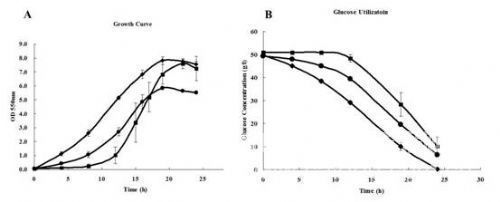Succinic acid is an excellent platform compound. It has a wide range of uses in the fields of chemicals, materials, medicine, and food. It is listed by the US Department of Energy as one of the 12 most valuable platform compounds in the future. As a C4 platform compound, it can be used to synthesize 1,4-butanediol, tetrahydrofuran, γ-butyrolactone, 2-pyrrolidone and the biodegradable material polybutylene succinate (PBS). Constructing an artificial cell factory for efficient production of succinic acid to efficiently convert renewable biomass resources into succinic acid has been a hot research topic in the world in recent years.
In terms of the supply of precursors for the synthesis pathway of succinate cell factory, Zhang Xueli, a research group of Tianjin Institute of Industrial Biotechnology, Chinese Academy of Sciences, conducted in-depth research. Phosphoenolpyruvate (PEP) is a key precursor compound for succinic acid synthesis. E. coli usually uses the PTS system for glucose transport and metabolism, but this approach will reduce the supply of PEP. In order to improve the ability of cells to supply PEP, it is necessary to use a non-PTS system for glucose transport and metabolism. Previous studies have shown that the combined regulation of the expression intensity of E. coli glucose transporter (GalP) and glucokinase (Glk) genes can increase the cell growth rate by 4 times and the glucose consumption rate by 10 times. On this basis, the research team studied the effects of glucose transporters and glucokinase from different sources (E. coli and Pseudomonas mobilis) on cell growth, glucose metabolism, and succinate synthesis.
The study found that: 1) In the PTS knockout cells, the use of Pseudomonas mobilis glucose transporter (Glf) faster than the use of E. coli glucose transporter (GalP) glucose metabolism rate; Glf and E. coli Glk encoding gene combination The regulated strain has the fastest glucose consumption rate, 30% higher than the strain regulated by the combination of GalP and E. coli Glk encoding genes, and 13 times higher than the starting strain (see figure); 2) For succinic acid production, use GalP to make butane The production of diacid increased by 20%, and the use of Glf increased the production of succinic acid by 41%.
These methods of transforming glucose utilization pathways have important guiding significance for optimizing the synthetic pathway efficiency of compounds with PEP as precursors (succinic acid, malic acid, fumaric acid, aromatic compounds). Related papers have been published online in Applied Microbiology Biotechnology.
Tianjin University of Science and Technology jointly cultivates graduate students Tang Jinlei and Dr. Zhu Xinna of Tianjin Institute of Workers and Colleges as co-first authors.

Comparison of cell growth (A) and glucose utilization (B) of E. coli wild type (square), GalP and Glk regulated strains (circle), Glf and Glk regulated strains (diamond)
oilet Cleaner,Toilet Tools,Rainwater Collection System,Rain Barrel Diverter
ZHEJIANG HAOCHUAN RUBBER &PLASTIC CO.,LTD , https://www.zjhaochuan.com